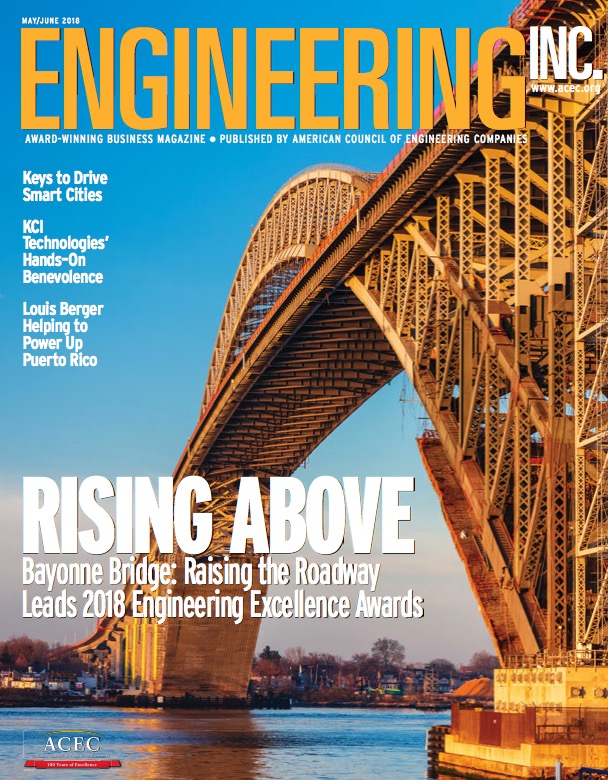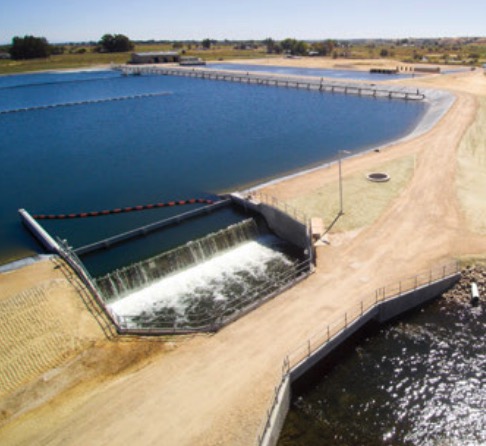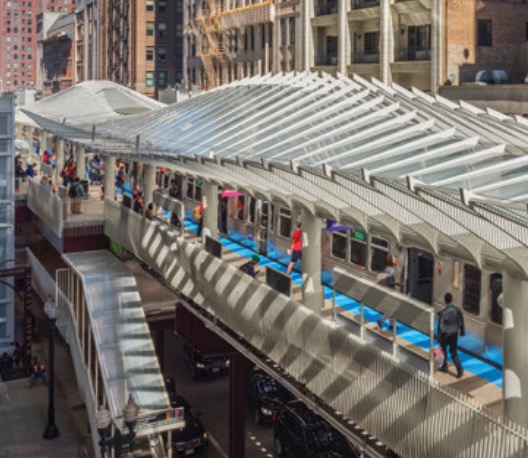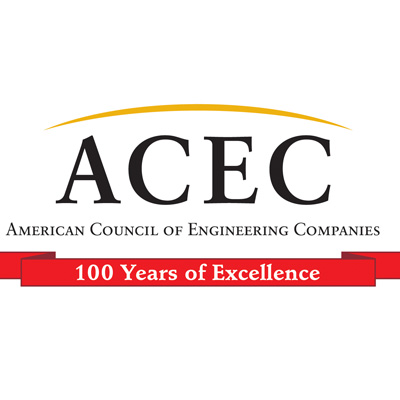AMERICAN COUNCIL OF ENGINEERING COMPANIES (ACEC)
The 2018 Engineering Excellence Awards Gala— known as the Academy Awards of the engineering industry— showcased 146 projects from across the country and around the world at a black-tie event on April 17.
A panel of 35 judges representing a wide spectrum of built environment disciplines had selected 36 top winners— including 20 Honor Awards, 15 Grand Awards and a Grand Conceptor Award for the year’s most outstanding engineering achievement.
Comedian and actor Kevin Nealon again hosted the Gala, which was attended by more than 600 members, guests and dignitaries.
2018 Grand Conceptor Award Winner
 Bayonne Bridge: Raising the Roadway
Bayonne Bridge: Raising the Roadway
Bayonne, New Jersey & Staten Island, New York
HDR | WSP USA (Joint Venture)
New York, New York
Imaginative engineering delivered a new highway 64 feet above the highway it was to replace, all within the tight confines of the same arch bridge. The bridge’s 151-foot navigation clearance was too low to accommodate the huge Panamax ships that will soon be plying the river, so the project increased the clearance by constructing a roadway above the existing one, which was then demolished. More than 4,000 tons of steel strengthening plates were needed to support the structure’s temporary doubleroadway condition during construction. Adding to the challenge, both the original roadway and the critical underlying shipping channel had to be kept open. In addition to increasing the vertical clearance, the bridge now has wider lanes, concrete medians, a shared-use path and can incorporate a light-rail line in the future.
View video: the Bayonne Bridge
Grand Awards
150 North Riverside
Chicago, Illinois
Magnusson Klemencic Associates
Seattle, Washington
A dazzling example of superstructure design, this new 54-story office building has transformed a previously barren, undeveloped site into a vibrant public complex. To overcome extremely tight site constraints, the project team developed a cutting-edge, blade core design that requires half the support pilings of a comparable building. At 750 feet, the 1.25-million-square-foot tower balances atop a base that is only 39 feet wide. Twelve water tanks at the top of the building contain 700 tons of water to help minimize building sway in strong wind conditions. A precast, prestressed concrete lid atop nearby railroad tracks provides space for a new public park featuring an amphitheater, pedestrian pathways and retail venues.
Tempe Town Lake Downstream Dam Replacement
Tempe, Arizona
Gannett Fleming
Phoenix, Arizona
As a shining example of innovative dam design, the new 880-foot-long dam is one of the largest hydraulically controlled hinged steel-gate dams of its kind. The dam replaces a previous structure that failed, draining 1 billion gallons of water from the lake within 24 hours. The dam has eight hydraulically operated steel gates, each weighing approximately 300,000 pounds. The new dam allows the river to flow during high-water events to prevent upstream flooding and maintains the lake’s key role in the city’s economy. Expected to last at least 50 years, this essential infrastructure ensures that Tempe Town Lake will remain a destination for recreation and center of economic development.
Second Avenue Subway—Phase 1
New York, New York
AECOM & Arup (JV)
New York, New York
The 1.8-mile project is the first major expansion of New York’s subway system in 50 years, with three new stations at 72nd, 86th and 96th streets, and upgrades to the existing 63rd Street station. The stations rank among North America’s largest underground excavations, at nearly 64 feet wide, 100 feet deep and 1,600 feet long. The project team overcame the challenges of building below some of the world’s most congested infrastructure and dealing with difficult ground conditions. The $4.45 billion project was completed on time and within budget—a major accomplishment for a project of this scope and size.
 Dixie Drain Phosphorus Removal Facility
Dixie Drain Phosphorus Removal Facility
Parma, Idaho
Brown and Caldwell
Boise, Idaho
An addition to the existing Dixie Drain—an agricultural and groundwater drain that discharges into the Boise River—has led to 50 percent more phosphorus being removed from treated water before it’s discharged into the river, which is a key provider of economic, aesthetic, wildlife and recreational benefits. The new facility processes up to 130 million gallons of ground and surface water daily while removing 140 pounds of phosphorus per day. The result is a cost-effective solution, resulting in significantly greater water quality and a model for other areas facing similar pollutant removal concerns.
University of Massachusetts Design Building
Amherst, Massachusetts
Simpson Gumpertz & Heger
Waltham, Massachusetts
One of the largest timber-framed buildings in the United States, the new UMass Design Building includes glue-laminated beams and columns and a cross-laminated timber composite with a concrete topping slab for the flooring. Combined, they provide the strength and the ductility needed to meet building code and user requirements. The structure also incorporates several sustainable design features, including rainwater retention systems, a green roof and natural lighting, while encouraging the use of timber framing for other large building applications.
Basin Creek Water Treatment Plant
Butte, Montana
HDR; Robert Peccia & Associates
Missoula, Montana
The new $30 million treatment plant is the first in the United States to use a cutting-edge ceramic membrane filtration system. Common in Japan and Europe, ceramic is more durable and chemical resistant, and has a longer life expectancy than commonly used polymer filters. Ceramic filters also waste significantly less water, resulting in 99.95 percent backwash recovery, well above the standard 85 to 95 percent recovery rate of conventional treatment technology. The treatment plant can process up to 7 million gallons of water per day and employs gravity to reduce energy consumption and make it unnecessary to pump water to the distribution system, except in instances of extreme demand.
35th Street Pedestrian Bridge
Chicago, Illinois
EXP
Chicago, Illinois
The striking 620-foot-long structure is Chicago’s longest pedestrian bridge and one of only a few mono-cable, self-anchored suspension bridges in the United States. Replacing a deteriorating structure that was inaccessible to those with physical disabilities, the new bridge provides an eye-catching crossing of Lake Shore Drive and Metra railroad tracks. It is anchored by a central pylon soaring more than 120 feet above Lake Shore Drive, with suspension cables anchored at the ends of the deck rather than in massive anchor blocks at abutments. The design also features a reverse horizontal curve to provide visitors with a panoramic view of the scenic lakefront area.
Crum Creek Viaduct
Swarthmore, Pennsylvania
Figg Bridge Engineers
Exton, Pennsylvania
The new five-span, 735-foot-long steel girder structure replaced an outdated rail viaduct bridge over Crum Creek by being slid into place. Before closure of the obsolete 121-year-old bridge, the project team assembled the superstructure and precast deck adjacent to the existing bridge supported by straddle bents built under the older structure. During the 11-week shutdown, the project team demolished the old bridge and laterally slid the new structure across the pier caps and onto permanent bearings using hydraulic jacks. Installation of rail connections, catenary transmission lines and signals quickly followed. Busy commuter train service resumed as scheduled on a safer and more contemporary structure.
Chicago Riverwalk
Chicago, Illinois
Benesch & Infrastructure Engineering
Chicago, Illinois
A testament to imaginative infrastructure design and construction, the new Chicago Riverwalk connects downtown with the Chicago River’s natural amenities. The Riverwalk is supported by an innovative system of canopied piers, or “underbridges,” that connect the walkway at six historic bridges. The precast walkways were installed atop drilled shafts that extend 70 feet beneath the water’s surface. New build-out sections ranging from 25 to 50 feet between each bridge provide diverse attractions and gathering spaces for people to enjoy the river and the enhancements to Chicago’s second shoreline.
Bahá’í Temple of South America
Santiago, Chile
Simpson Gumpertz & Heger
Waltham, Massachusetts
Envisioned to “capture the sunlight and be transformed by it” during daylight and “glow with a dreamlike serenity” at night, the breathtaking Bahá’í temple more than accomplished its goals. Located in the foothills of the Andes Mountains outside of Santiago, Chile, the temple’s superstructure is composed of nine translucent wings. The underlying structures are free-form tubular space trusses rising to a top ring at the structure’s oculus. The space trusses are clad on the outside with borosilicate glass panels and on the interior with Portuguese marble panels. The project team constructed this complex, free-flowing design in a remote site with high seismic activity, creating one of the world’s most breathtaking centers of worship.
Lotte World Tower
Seoul, South Korea
Syska Hennessy Group
New York, New York
Ranked as the world’s fifth-tallest building and the tallest in South Korea, the Lotte World Tower is also a technical marvel. The 1,821-foot-tall, 123-story state-of-the-art superstructure features geothermal, photovoltaics and windspire turbines to supplement conventional power with renewable energy sources. High-tech controls monitor and adjust power usage, external shading and dimming systems to fine-tune interior temperatures and light levels. The 3.2-million-square-foot tower features a luxury hotel, a shopping mall, offices, residences and entertainment venues.
Augmentation & Relief Sewer
Columbus, Ohio
DLZ Corporation
Columbus, Ohio
The new relief sewer reduces combined sewer overflows in the rapidly growing Columbus downtown area and brings the city into compliance with new clean water regulations. Nearly 2 billion gallons of combined sewage that previously overflowed directly to the Scioto River each year now flows through a new 23,000-foot-long, 20-foot-diameter tunnel for proper treatment at a nearby treatment plant. The additional storage volume eliminates the need for future above-ground structures and treatment systems, saving the city as much as $175 million.
 Washington Wabash Elevated Train Station
Washington Wabash Elevated Train Station
Chicago, Illinois
EXP
Chicago, Illinois
The striking new elevated train station features canopies of skeletal steel and faceted glass that undulate along Chicago’s Jewelers Row while producing a dynamic play of light on the platform and street below. The project team implemented unique construction phasing and sequencing to build the station in a dense urban environment, maintain active transit service in a heavily traveled corridor, and minimize the impact on vehicular and pedestrian traffic. The station serves as a beautiful gateway to downtown Chicago attractions while enhancing perceptions of public transportation.
Water Jet Peening Bridge Crane System
Burlington, Kansas
Merrick & Company
Greenwood Village, Colorado
A unique specialty crane deploys a process called Water Jet Peening (WJP), which extends the operational life of key nuclear reactor components by preventing corrosion and cracking. Weighing more than 179,000 pounds and operated by remote control, the specialty crane—which can hoist 3 tons—lifts, lowers, positions and supports two WJP tools— each the size of a small car— into the reactor vessel during an outage. The process uses only water to relieve stresses thus eliminating the potential for any foreign materials entering the reactor pool. The combined crane and WJP process reduces maintenance and operation costs, shortens outage durations, extends reactor life and minimizes risk to both the reactor vessel and plant personnel.
I-91 Brattleboro Bridge Improvements
Brattleboro, Vermont
Figg Bridge Engineers
Exton, Pennsylvania
Soaring 100 feet above the West River, the new three-span, 1,036-foot-long arching bridge provides a dynamic gateway to Vermont. The innovative design includes two “quad wall” piers made of concrete columns that curve symmetrically outward in two directions. The quad wall system provides stability and allows the segmental construction of the bridge superstructure to be assembled from above without temporary falsework in the river. The bridge’s landmark aesthetics and innovative structural design will safely and reliably serve regional motorists for at least 150 years.
Download full list: 2018 Engineering Excellence Award Winners
Download May/June issue of Engineering, Inc.
 About the American Council of Engineering Companies
About the American Council of Engineering Companies
www.acec.org
The American Council of Engineering Companies (ACEC) is the voice of America’s engineering industry. Council members – numbering more than 5,000 firms representing more than 500,000 employees throughout the country – are engaged in a wide range of engineering works that propel the nation’s economy, and enhance and safeguard America’s quality of life. These works allow Americans to drink clean water, enjoy a healthy life, take advantage of new technologies, and travel safely and efficiently. The Council’s mission is to contribute to America’s prosperity and welfare by advancing the business interests of member firms.
Tags: 2018 Engineering Excellence Awards, ACEC, American Council of Engineering Companies, Engineering, Engineering Excellence Awards, Engineering Inc.






 RSS Feed
RSS Feed